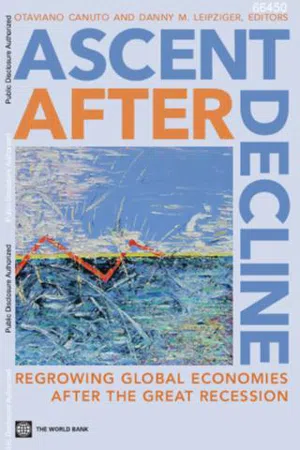
Ascent after Decline
Regrowing Global Economies after the Great Recession
- English
- PDF
- Available on iOS & Android
Ascent after Decline
Regrowing Global Economies after the Great Recession
About this book
This volume combines the analyses of leading experts on the various elements affecting economic growth and the policies required to spur that growth. Ascent after Decline: Regrowing Global Economies after the Great Recession identifies the main challenges to the economic recovery, such as rising debt levels, reduced trade prospects, and global imbalances, as well as the obstacles to growth posed by fiscal conundrums and lagging infrastructure. It also examines the way forward, beginning with the role of the state and then covering labor markets, information technology, and innovation. The common thread throughout the book is the view that economic re-growth will depend in large measure on smart policy choices and that the role of government has never been more crucial than at any time since the great depression. As members of the World Bank community, these issues are of particular importance to us, since without a resurrection of strong economic growth in major economies, the likelihood of rapid economic development in poorer developing countries is dampened. This is troubling because we have seen progress in many parts of the globe in the past decade, including in Africa, and these gains will be arrested as long as the global economy is in disarray. Donors will withdraw, investment will retrench, and prospects will dim. This immiserizing welfare outcome is to be avoided. The volume is intended to shed light on those areas of policy that reduce the prospects of a prolonged period of stress and decline by 'regrowing growth.'
Frequently asked questions
- Essential is ideal for learners and professionals who enjoy exploring a wide range of subjects. Access the Essential Library with 800,000+ trusted titles and best-sellers across business, personal growth, and the humanities. Includes unlimited reading time and Standard Read Aloud voice.
- Complete: Perfect for advanced learners and researchers needing full, unrestricted access. Unlock 1.4M+ books across hundreds of subjects, including academic and specialized titles. The Complete Plan also includes advanced features like Premium Read Aloud and Research Assistant.
Please note we cannot support devices running on iOS 13 and Android 7 or earlier. Learn more about using the app.
Information
Table of contents
- Contents
- About the Editors and Contributors
- Preface
- Acknowledgments
- Abbreviations
- Part 1 Diagnosing the Challenges
- Part 2 The Way Forward
- Index
- Box
- Figures
- Tables